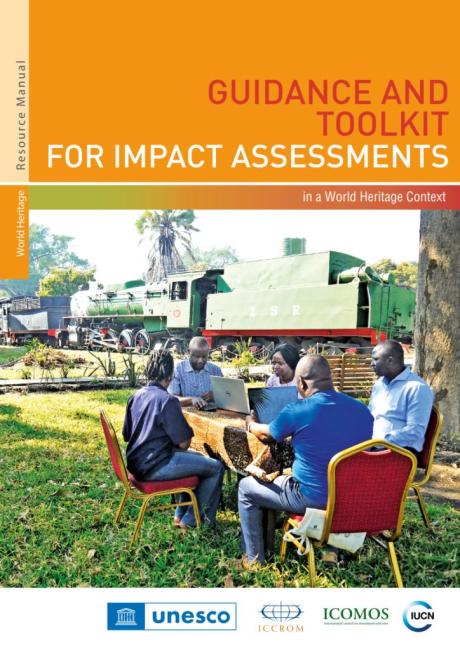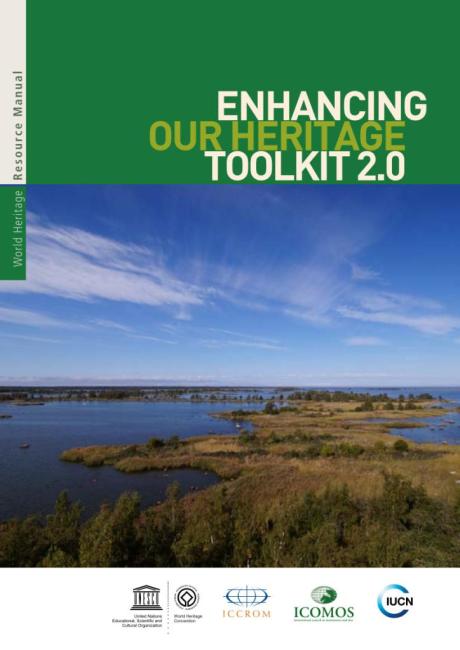Tourism and visitor management
- The
World Heritage Convention
The Convention Concerning the Protection of the World Cultural and Natural Heritage is an international treaty adopted by the UN in 1972 that defines the kind of natural or cultural sites which can be considered for inscription on the World Heritage List for their Outstanding Universal Value for all humankind. Commonly known as the World Heritage Convention, it establishes how the international community as a whole is responsible for
the protection of such heritage and sets out the duties of States Parties in identifying potential sites that may be eligible for inscription onto the World Heritage List and their role in protecting and preserving them. By signing the Convention, each country pledges to conserve not only the sites situated on its territory that have been recognized as being of Outstanding Universal Value, but also to protect its national heritage and to be involved in international efforts to protect, conserve and promote the heritage of humankind. encourages State Parties to present heritage to the public to foster stronger appreciation and support for its conservation. - Visitation and tourism have to be actively managed to bring benefits to local communities, while ensuring that the heritage is protected.
- Sustainable tourism is characterized by participation, inclusiveness, and shared responsibility of rights-holders and tourism stakeholders.
- Indigenous Peoples and local communities should play a critical role in tourism planning and implementation.
- A significant proportion of tourism-derived income should be directed back to support heritage protection and management.
- Heritage interpretation is essential at any heritage place and can be understood as any meaningful activity that helps people increase their understanding of the heritage place.
The
World Heritage Convention
The Convention Concerning the Protection of the World Cultural and Natural Heritage is an international treaty adopted by the UN in 1972 that defines the kind of natural or cultural sites which can be considered for inscription on the World Heritage List for their Outstanding Universal Value for all humankind. Commonly known as the World Heritage Convention, it establishes how the international community as a whole is responsible for
the protection of such heritage and sets out the duties of States Parties in identifying potential sites that may be eligible for inscription onto the World Heritage List and their role in protecting and preserving them. By signing the Convention, each country pledges to conserve not only the sites situated on its territory that have been recognized as being of Outstanding Universal Value, but also to protect its national heritage and to be involved in international efforts to protect, conserve and promote the heritage of humankind.
is based on the premise that some heritage places are important to the entire world, therefore
States Parties
The countries which have adhered to the Convention Concerning the Protection of the World Cultural and Natural Heritage (
World Heritage Convention
The Convention Concerning the Protection of the World Cultural and Natural Heritage is an international treaty adopted by the UN in 1972 that defines the kind of natural or cultural sites which can be considered for inscription on the World Heritage List for their Outstanding Universal Value for all humankind. Commonly known as the World Heritage Convention, it establishes how the international community as a whole is responsible for
the protection of such heritage and sets out the duties of States Parties in identifying potential sites that may be eligible for inscription onto the World Heritage List and their role in protecting and preserving them. By signing the Convention, each country pledges to conserve not only the sites situated on its territory that have been recognized as being of Outstanding Universal Value, but also to protect its national heritage and to be involved in international efforts to protect, conserve and promote the heritage of humankind.
) (UNESCO, 1972).
should create programmes that strengthen people’s appreciation and respect for these outstanding places. The success of the Convention is evident in the large numbers of people who have been inspired to visit World Heritage properties to understand more about the world’s natural and cultural diversity. Visitation, when effectively managed, helps promote
cross-cultural exchange and contribute to the well-being and livelihoods of local communities.
However, visitors can also have negative impacts on the heritage place and its communities, from damage to the physical fabric of the heritage place through over-use, to social disruptions, to contributing to global environmental problems, such as carbon emissions from air transport, waste production, and the spread of invasive species. Visitation needs to be managed at multiple levels to avoid these negative impacts, especially in the case of mass tourism. Managers, therefore, need to be aware of the trends in visitation to their own heritage place so that they can identify management measures that promote forms of tourism compatible with sustaining heritage values and OUV, and instrumental in celebrating cultural and biological diversity, helps to improve quality of life within communities, reduces negative environmental impacts and supports conservation efforts.
This requires coordination with multiple actors and broad scale approaches that position the entire heritage place within a likely broader tourism destination. This is because tourism is a complex activity that includes travel, accommodation, visits and activities to a range of locations, many of which take place outside the boundaries of individual World Heritage properties. That is why those working with tourism often differentiate between a tourism destination (e.g. the wider region, landscape or town) and visitor attractions (an individual location of interest to visitors, e.g. a monument, museum, geological feature or viewpoint), because different approaches can be taken at each level. Understanding the current form of visitation to distinguish the various types of visitors is very important. This can include tracking whether the visitors are from the local and domestic sphere or international, or understanding the different focus of the visit, whether it is on tourism, educational purposes or religious pilgrimages, etc.
Heritage All inherited assets which people value for reasons beyond mere utility. Heritage is a broad concept and includes shared legacies from the natural environment, the creations of humans and the creations and interactions between humans and nature. It encompasses built, terrestrial, freshwater and marine environments, landscapes and seascapes, biodiversity, geodiversity, collections, cultural practices, knowledge, living experiences, etc. managers should ensure that visitation and tourism strategies are fully aligned with management objectives for the heritage place, both from a conservation and benefits-sharing perspective. While such strategies will necessarily be shaped by local circumstances, there are some important shared principles for any heritage place:
- Decision-making on tourism at a heritage place needs to be participatory.
Tourism affects and involves many people within and around a heritage place, therefore, any planning and decision-making on tourism requires meaningful engagement from various actors.
Heritage
All inherited assets which people value for reasons beyond mere utility. Heritage is a broad concept and includes shared legacies from the natural environment, the creations of humans and the creations and interactions between humans and nature. It encompasses built, terrestrial, freshwater and marine environments, landscapes and seascapes, biodiversity, geodiversity, collections, cultural practices, knowledge, living experiences, etc.
managers and particularly rights-holders including Indigenous Peoples, need to be fully involved in any planning affecting them, through their own representative institutions, in order to prevent negative impacts of tourism on their societies, traditional livelihoods, and cultures.
- Tourism planning should support the protection and interpretation of OUV and other heritage values of the place.
The conservation of an agricultural landscape can be supported for instance by encouraging visitors to eat locally-produced foods. If a historic town is at risk of depopulation and consequent vacant historic houses, then tourism could focus on providing employment opportunities and incentives by creating home-stay accommodation run by the local residents. Tourism activities initiated and driven by Indigenous Peoples and local communities can highlight traditional practices and provide memorable tourism experiences; for example a heritage place that protects traditional fishing can use this as a tourism asset to generate additional income for local people. In some heritage places, community empowerment through tourism services and interpretation has been achieved through the accreditation of guides and tours. Considerations need to be taken to ensure that tourism will not negatively affect the state of conservation of the heritage place, for example by prohibiting or restricting access to sensitive areas (e.g. sacred sites or protected habitats) or limiting the numbers of people who can access those areas; providing visitor access such as boardwalks or grouped transportation options to manage access routes; enhancing visitor experiences without impact through the use of virtual tourism and information technology etc.
- Tourism should contribute directly to local aspirations for sustainable development and benefit sharing.
Tourism benefits should be retained as much as possible at local levels to ensure benefits are optimized and equitably shared. Tourism strategies should recognize that heritage places need to be carefully protected and managed to continue generating a wide range of benefits. Income from tourism can be generated in many ways, including tourism taxes, donations from tourism businesses, ticket sales, etc. A significant proportion of this needs to be re-invested back into the heritage place, by ensuring that managers can use financial mechanisms to collect and retain tourism revenue and apply it directly to management and maintenance needs. Too often heritage managers and local communities bear all the costs of maintaining heritage places but do not see any of the tourism benefits that stay at site level.
- Tourism should provide visitor experiences that are specific to the heritage place.
Visitor experience at a heritage place can be engaging and memorable if it is based on the specificities of the place and a clear understanding of its heritage values. Local products and tourism activities that truthfully relate to the place and its heritage and cannot be purchased or experienced elsewhere, help convene a sense of place to visitors.
- Indigenous Peoples and local communities’ rights, aspirations and concerns need to inform visitor management.
Indigenous Peoples and local communities should have the opportunity to tell their stories about the place through their tourism enterprises so that visitors have a better understanding of their connection with the land and seascapes and of their traditional practices. Recognizing that visitation and tourism can have many negative socio-cultural impacts, it is critical to ensure that contact with local communities and Indigenous Peoples is desired and that tourism related activities do not
result in commercialization and commodification of cultural practices, disruption of traditional occupations and livelihoods, rapid changes in social structures, eviction and displacement of local people, and increased crime. Therefore, careful considerations need to be made and rights-holders’ concerns should be at the core of tourism planning and visitor management.
- Visitation should be managed based on the heritage place’s carrying capacity and appropriate uses that help maintain its heritage values.
Heritage
All inherited assets which people value for reasons beyond mere utility. Heritage is a broad concept and includes shared legacies from the natural environment, the creations of humans and the creations and interactions between humans and nature. It encompasses built, terrestrial, freshwater and marine environments, landscapes and seascapes, biodiversity, geodiversity, collections, cultural practices, knowledge, living experiences, etc.
places will have limits as to the numbers, patterns, spatial and temporal distributions of visitors. This is a nuanced issue and requires expert analysis and research. However a range of visitor management mechanisms, strategies and tools are available to heritage managers to ensure use limits are not exceeded resulting in unacceptable negative impacts on the attributes of the heritage place as well as to local communities.
- Development related to tourism and interpretation should be subject to impact assessment processes.
Facilities and infrastructure development to support tourism and interpretation of the heritage place should be considered in the same way as other forms of development. These changes should also be subject to appropriate impact assessment processes and decisions need to be based on the heritage values of the place.
Heritage interpretation is essential to ensure that visitors to World Heritage properties have meaningful experiences that deepen their understanding and appreciation for the conservation of these outstanding places. Heritage interpretation is often a common ingredient of many heritage-related activities, for example, environmental education, guided tours, events and festivals, storytelling, exhibitions, site and museum displays, and experiential or hands-on activities. Such activities can go beyond simply providing information and can make respectful connections between people and places. More importantly, when heritage interpretation is planned well on the basis of learning, communication, psychology, and behaviour theories, it can support a change in a person’s attitudes, fostering an increased appreciation of the heritage. That appreciation can then be the springboard for behavioural changes to support ongoing heritage use and enjoyment, as well as its conservation for the future. Therefore, heritage interpretation, when fully understood, planned and executed, has a significant contribution to play towards the goals of the
World Heritage Convention
The Convention Concerning the Protection of the World Cultural and Natural Heritage is an international treaty adopted by the UN in 1972 that defines the kind of natural or cultural sites which can be considered for inscription on the World Heritage List for their Outstanding Universal Value for all humankind. Commonly known as the World Heritage Convention, it establishes how the international community as a whole is responsible for
the protection of such heritage and sets out the duties of States Parties in identifying potential sites that may be eligible for inscription onto the World Heritage List and their role in protecting and preserving them. By signing the Convention, each country pledges to conserve not only the sites situated on its territory that have been recognized as being of Outstanding Universal Value, but also to protect its national heritage and to be involved in international efforts to protect, conserve and promote the heritage of humankind.
and can build strengthened public support for a heritage place. Heritage interpretation led by local residents contributes to sustainable tourism that reinforces place-based identity and provides benefits for local communities.
- Is there a good understanding of the scope of impacts of tourism (both positive and negative) on the heritage place, the limits of acceptable change and the carrying capacity of the place so as to ensure heritage protection?
- Are there mechanisms in place to share tourism benefits with local communities and to support conservation actions for the heritage place?
- Does the heritage place have a heritage interpretation plan to guide the implementation of visits and other activities? Is that plan based on a clear understanding of the range of values of the heritage place?
- Have other ways of presenting the heritage place to the public beyond physical visits (virtual presentation, educational material, outreach programmes, etc.) been considered?
- Who is currently visiting the heritage place and why? Who is currently being excluded from visiting the heritage place and why?
- UNESCO World Heritage All inherited assets which people value for reasons beyond mere utility. Heritage is a broad concept and includes shared legacies from the natural environment, the creations of humans and the creations and interactions between humans and nature. It encompasses built, terrestrial, freshwater and marine environments, landscapes and seascapes, biodiversity, geodiversity, collections, cultural practices, knowledge, living experiences, etc. Sustainable Tourism Toolkit.
- ICOMOS (2008). ICOMOS Charter on the Interpretation and Presentation of Cultural Heritage All inherited assets which people value for reasons beyond mere utility. Heritage is a broad concept and includes shared legacies from the natural environment, the creations of humans and the creations and interactions between humans and nature. It encompasses built, terrestrial, freshwater and marine environments, landscapes and seascapes, biodiversity, geodiversity, collections, cultural practices, knowledge, living experiences, etc. Sites.
- ICOMOS (2022) ICOMOS International Charter for Cultural Heritage All inherited assets which people value for reasons beyond mere utility. Heritage is a broad concept and includes shared legacies from the natural environment, the creations of humans and the creations and interactions between humans and nature. It encompasses built, terrestrial, freshwater and marine environments, landscapes and seascapes, biodiversity, geodiversity, collections, cultural practices, knowledge, living experiences, etc. Tourism.
- Leung, Y., Spenceley A., Hvenegaard, G., and Buckley, R (eds.) (2018). Tourism and visitor management in protected areas: Guidelines for sustainability. Best Practice Protected Area Guidelines Series No. 27, Gland (Switzerland), IUCN, Switzerland.
- Borges, M.A., Carbone, G., Bushell, R. and Jaeger, T. (2011) Sustainable Tourism and natural World Heritage All inherited assets which people value for reasons beyond mere utility. Heritage is a broad concept and includes shared legacies from the natural environment, the creations of humans and the creations and interactions between humans and nature. It encompasses built, terrestrial, freshwater and marine environments, landscapes and seascapes, biodiversity, geodiversity, collections, cultural practices, knowledge, living experiences, etc. – Priorities for action, pp 29, Gland (Switzerland), IUCN, Switzerland.
- IUCN (2022) Sustainable Tourism and Protected Areas in a Post-COVID World.
- Spenceley, A., Kohl, J., McArthur, S., Myles, P., Notarianni, M., Paleczny, D., Pickering, C. and Worboys, G. L. (2015) ‘Visitor management’, in Worboys, G.L., Lockwood, M., Kothari, A., Feary, S., and Pulsford, I. (eds) Protected Area Governance and Management, pp. 715–750. Canberra (Australia), ANU Press.
- UNESCO, BfN (2021). UNESCO Visitors Count! Guidance for protected areas on the economic analysis of visitation.
- WHIPIC (2024). Handbook for Interpreting and Nominating Sites of Memory.
- WHIPIC (2022). World Heritage All inherited assets which people value for reasons beyond mere utility. Heritage is a broad concept and includes shared legacies from the natural environment, the creations of humans and the creations and interactions between humans and nature. It encompasses built, terrestrial, freshwater and marine environments, landscapes and seascapes, biodiversity, geodiversity, collections, cultural practices, knowledge, living experiences, etc. : 50 years and moving forward, An Anthology of World Heritage All inherited assets which people value for reasons beyond mere utility. Heritage is a broad concept and includes shared legacies from the natural environment, the creations of humans and the creations and interactions between humans and nature. It encompasses built, terrestrial, freshwater and marine environments, landscapes and seascapes, biodiversity, geodiversity, collections, cultural practices, knowledge, living experiences, etc. Interpretation and Presentation.



